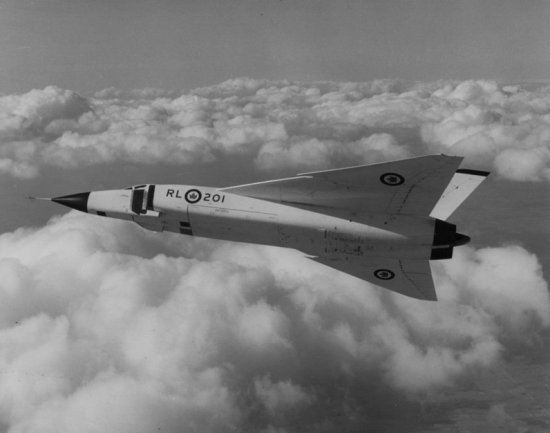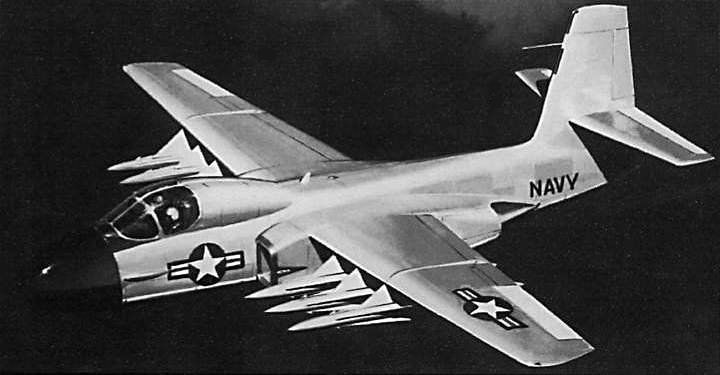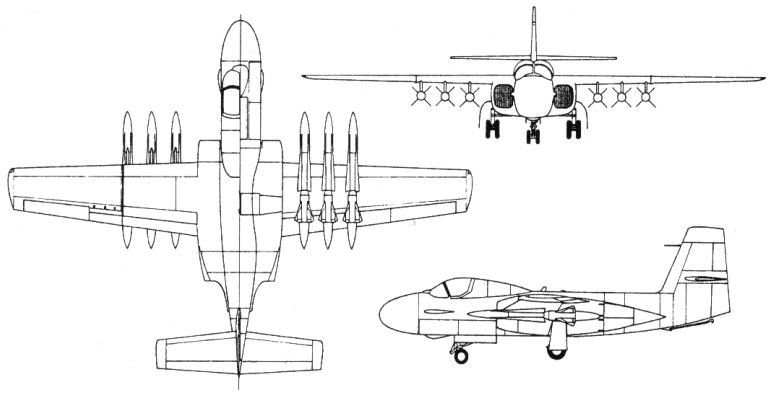An Airplane's History

At the end of the Second World War and just as the Cold War was going through some of its frostiest relations. Both the Soviets and the Western Powers were reviewing their options to fight a new type of war. That is a war with nuclear weapons. It basically boiled down to this in the aviation world:
You built an airplane to be able to deliver a nuclear weapon:


Or you built an aircraft to prevent the first mission:




The United States Navy was in a very interesting position. It had fleet fighters that could attempt to mix it up with tactical aircraft over the fleet. Such aircraft as the F8U Crusader, F3H Demon, F11F Tiger and the recent new comer the F4H-1 Phantom. However as the Office of Naval Intelligence started to see the ways the Soviets would attempt to kill a carrier these fighters didn't look that powerful at all. The ONI looked around and realized that the way the Soviets were going to attempt to kill a carrier was either through attack by the submarines using torpedoes or cruise missiles, surface ships mounting cruise missiles, or by long range bombers such as the Tu-16 Badger or Tu-95 Bear armed with large cruise missiles such as the AS-4 Kitchen or AS-5 Kelt to deliver either a large warhead or nuclear warhead against a carrier battle group. The planing and intention folks in ONI took a look around at the aircraft and then realized the current generation of fighters just didn't have the range nor the staying power to stay on station as far as possible from the battle group ready to intercept a massive bomber formation coming from the Kola or Crimea Peninsulas.
What was needed was an airplane mounting a large radar that was capable to see a far way out from the plane, the ability to carry a butt ton of gas to hang around at the long reaches from the battle group, and finally it was going to be armed with a long range powerful missile. So BuAir submitted the official request for an interceptor that had to have a good loiter time, a very good intercept radar system (to the point that it could do the search and intercept on its own with out assistance), and be capable of possibly carrying one of two planned missiles the AIM-47 Falcon or the AAM-N-10 Eagle.
The Douglas Aircraft Company submitted a design to compete in this bid. It was a straight wing monoplane, with a large bubble canopy designed to sit two aircrew side by side and a third in a special radar compartment near the rear, its was going to mount a radar dish that was about five feet across in a large bulbous nose, finally it was going to be subsonic. Navy officials looking at the drawings commented that it basically appeared to be the F3D Skyknight just grown bigger.




Douglas won the competition in 1959 and began to further design the aircraft. It was going to be powered by Pratt and Whitney TF30-P-2 engines and be armed with the Grumman Aerospace company AAM-N-10 Eagle missiles. A series of other things came into being at this time as well to make this planned weapon system look very good together. Grumman just won the contract to build the follow on to the WF-1 Tracer, the W2F-1 Hawkeye which was going to be capable of data linking radar information between itself and the carrier battle group along with selected interceptors. The other thing that was coming on line though very slowly was the new Navy Tactical Data System, or NTDS, this was a series of computers built around a UNIVAC computer system which was going to receive all the radar data from the battle group in a specific data link and present it back out to the various Combat Information Centers, CICs. That way the battle group commander and his various warfare commanders could gain a better handle on what was all going on around them. The advantage the F6D was going to have is that its radar system the Hughes APQ-81 tied in with the APS-125 of the W2F, that way the Hawkeye could successfully guide the Missiler to the right steering an line up for a missile shot even before the bad guys knew there was anyone else out there. On top of that if the F6D was on its own as it relayed its own radar data back to the W2F or the Carrier the air defense officer could have a better view of what was going on around the battle group.
As it was when the F6D Missiler was announced there was strong resistance from the fighter community with inside the US Navy. The idea of just being a launching platform for the Eagle just didn't sit well with some of these fighter pilots. On top of that the tactics being expressed just didn't seem to make sense at the time either. Questions about was a carrier air wing going to give up a fighter squadron to be equipped with this long range all-weather interceptor. What would of happened when the Missiler shots its load of Eagles at an incoming bomber stream? Just pull out of the way and wait for the carnage to end in the hope that the next set of defense lines could properly defend the battle group? What about about the need to cross the beach in support of a strike package? Obviously this airplane couldn't mix it up with the light weight tactical fighters (such as the MiG-17 and MiG-19) the Soviets were using. In the end BuAir decided to put a hold on this aircraft in 1961. Overall it was an interesting though and a different challenge to the defense of the carrier battle group from an bomber/cruise missile attack. At various times through out both the Kennedy and Johnson administrations the idea of the Eagle and Missiler were dusted off only to be finally killed in 1967 as some of the lessons learned from the Have Doughnut and Have Drill exercises at Nellis testing ranges, along with the huge costs of both developing the radar set, missile system and airframe were approaching costs that at the time the national defense budget couldn't afford.
Not all was lost though. A number of ideas from the F6D Missiler were retained for usage in the next fighter project being developed for the United States Navy. This project was the Tactical Fighter Experimental or TFX program. It was going to mount a radar system that though not as large as the APQ-81 it was going to try and be as powerful, this radar system was going to be the AWG-9, also the lessons learned from the development of both the AIM-47 Falcon and the AAM-N-10 Eagle were combined to create the AIM-54 Phoenix missile. Finally with the further refinement of the aerial refueling store and conversion of selected aircraft into dedicated tankers the idea of having a six hour loiter time was lowered and instead the tactic of "Chainsaw" was begun to be developed. Chainsaw was where everything that wasn't a fighter or AEW aircraft was uploaded with a buddy store. Then during an incoming Soviet bomber regiment raid a group of fighters and a tanker would be launched. The tanker (or aircraft with the buddy store) would fly with the fighters then top the fighters off as they would start to run dry. The tanking aircraft would turn and run home, get gas and fly back out to join up with their assigned charges fly even further out to get as far as possible from the battle group. At which the AEW aircraft would begin to assign a pair of Fleet Defense Interceptors to let loose with their missiles, finally closing range to get as many as possible with the on board gun system. Until the penetration of the battle group SAM belt was achieved.
















<< Home